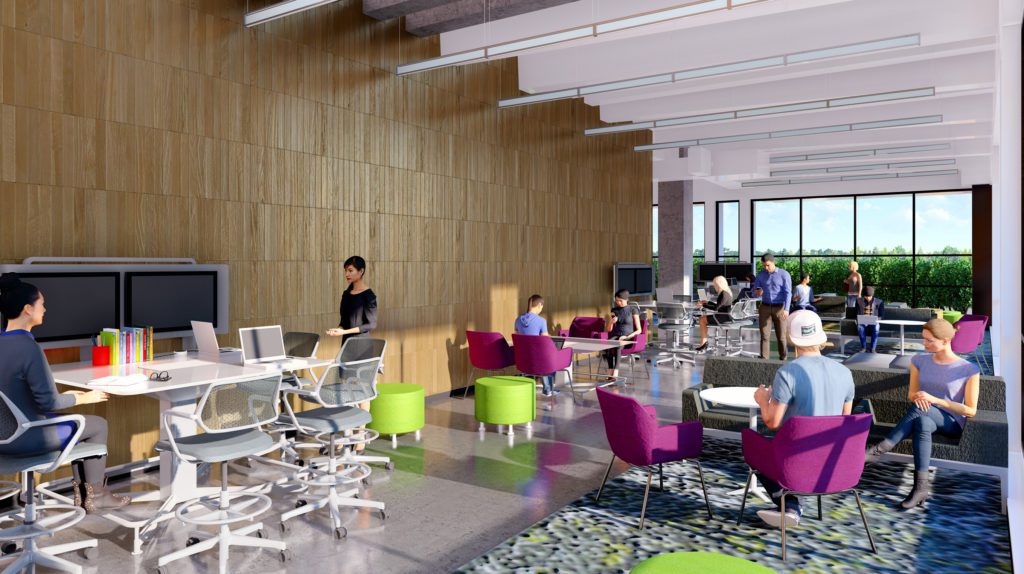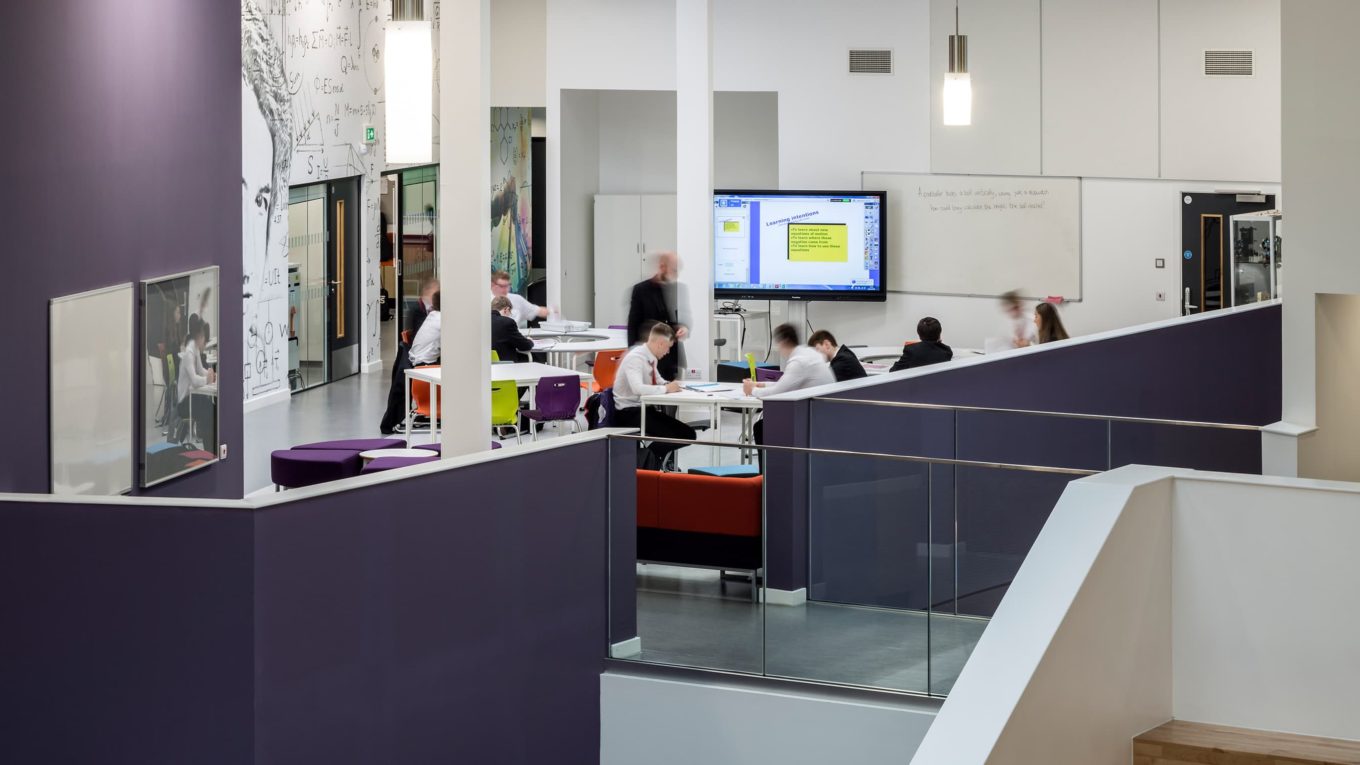Impactful collaborative learning spaces are a cornerstone of design in our schools. Across the spectrum of early childhood education, K-12 and higher education, connected classrooms are a given. While the pandemic has reduced the physical connection of students in the classrooms in the short term, this experience has guided us to reimagine collaboration for the mid to long-term that considers how remote learners connect with in-classroom students.
How do we promote interdisciplinary collaboration with multiple access points and viewpoints in classrooms that can be interactively shared between students and teachers? How does a school’s identity, values and culture get conveyed through design? As part of our 2021 Insight Series, David Clusiau, Vice President of Design, hosts a roundtable with integrated team members in our Education sector to answer these questions and consider how design is playing a role in the future of education.
How is the traditional classroom transforming to open collaborative spaces?
David Clusiau, Vice President
At the higher education level, the traditional classroom is being replaced by flexible collaborative spaces. There is a recognition that learning is continuous and can occur in informal breakout spaces with your peers, as much as in seminar rooms and tutorial areas. The traditional classroom is also losing ground. The amount of digitally-delivered content is rising and importance is being placed on providing facilities for hands on labs and studios, as well as spaces that allow students to work as teams and lead the discussion. At the same time, Universities and Colleges are breaking down silos and pursuing cross-disciplinary learning and research. These two forces are driving innovation and creating design opportunities in the more formal classroom/lab/studio environment, as well as the surrounding common spaces which are often no longer just corridors, but rather multipurpose zones where different disciplines come together.
Contributing to the activation of these zones, we are finding an increasing interest at Colleges and Universities in storefront display windows. For example, at McMaster DeGroote Centre for Learning and Discovery and the Mohawk College E wing Redevelopment, passersby can view the activity in a classroom, lab or studio. This transparency puts the science or art on display and allows prospective students, staff and donors insight into ongoing activities and facilities inspiring engagement and participation.
Chaderique Menard, Principal
As mixed disciplines are converging into schools, we are designing active learning environments with technology-rich elements that support collaborative teaching spaces. By adding these collaborative spaces, we can facilitate sharing across disciplines. In the Wayne State University STEM Innovation Center, we designed these areas to be ‘collision spaces’ where members of different faculty literally collide by sharing their ideas on whiteboards and multi-purpose screens.
The reality of moving to a flexible and collaborative design model is that it allows any academic building to adjust to ever-changing learning and social interaction models. These are some common design elements:
- Flexible classrooms that incorporate moveable furniture
- Subdividing rooms with moveable or swing partitions
- Multipurpose workshops and laboratories with moveable worktops and storage
- Flexible break-out spaces or collisions areas. This allows larger areas to maneuver around and create impromptu meeting areas
- Flexible break out spaces that can connect to one another
- Rooms that can open into hallways, creating larger interactive spaces

Kevin Cooper, Principal
In the UK, the boundaries are being blurred between different ages and stages of education. For example, the West Calder Highschool project has multiple collaborative spaces that mimic the higher education model. Schools are becoming less cellular and more open. These larger spaces are also arguably more helpful during a pandemic, allowing for safe movement and more space. In Scotland, we are deconstructing corridors and traditional classrooms to create more opportunities for agile, adaptable learning out of the same space. What was a flexible learning space, informal lunch area or even a circulation route can become a major performance space in the evening.
What commitments to sustainability and carbon emission targets are we realizing in the education sector?
David Clusiau, Vice President
Students are demanding more from their schools, and that includes social responsibility. We’re seeing a renewed dedication to sustainability, and we’re engaging students and faculty to participate. At the E-Wing building redevelopment at Mohawk College in Hamilton, ON, quite ambitious energy conservation targets are being set and the students in the Building and Construction Sciences program are helping with the design of the building through the curriculum. The process becomes a teaching moment unto itself, helping construct a 3D scan of the existing site, developing a cladding system where performance can be monitored, exploring solar energy components on an adaptable armature on the south side of the building and even speculating on how to include hydrogen into the building.
Tobias Fellows, Principal
Canadian Universities and Colleges are also starting to target Carbon. They are using standards like the Passive House EnerPHit program enabling institutions to upgrade their facilities over time. Many Universities are facing a massive challenge to modernize their aging campus buildings. Improving the student’s learning environment is a priority for all educational providers as it leads to better student outcomes. Inefficient buildings are costing the university valuable financial resources that could be used to improve occupant comfort, student life and learning environments. By retrofitting buildings now, Universities can turn what may have been a burden into a real asset attracting the best and brightest students to their campus.
The University of Toronto’s Queen’s Park Building is an example where we are making critical improvements to the envelope of this historic building. We are giving the building a second life, and by reusing its embedded carbon, we are reducing the impact on the environment while retaining an essential part of the University’s built legacy.
Kevin Cooper, Principal
In Scotland, the Passive House certification is leading the charge in sustainable education buildings. As designers, we are aware of our duty to help achieve collective societal sustainability goals. In the public sector in general, and in the education sector in particular, these ambitions have been reflected in the creation of very onerous energy performance targets. It’s a balancing act between building performance and great design.
A school like Bertha Park is intrinsically sustainable. It has incredibly strong form and function and an exceptional well flow data ratio. The school is also radically innovative, certified as one of just 17 education centers that make up the Microsoft Flagship Initiative.
How do we create more production, healthier and energetic learning environments?
Chaderique Menard, Principal
We take a holistic view of design strategies in creating the campus-built environment for best learning outcomes. Design elements such as introducing natural lighting and biophilic features can have long-lasting dramatic impacts on active learning environments. Studies have shown that incorporating planting materials into an indoor space has shown to increase creativity and reduce absenteeism, with studies recording an 8% increase in productivity and a 13% increase in inhabitants’ well-being. Not only does it create a relaxing Zen-type atmosphere but can be used to naturally filter out toxins in an indoor setting.
The pandemic has also surfaced the need for outdoor learning spaces. The use of sheltered outdoor learning areas can be utilized as an alternate work environment or teaching space. If we design them to be sheltered from the elements, providing covered areas with thermally heated slabs, we can elongate the usability of these spaces through the seasons.
How does a school’s identity, values and culture get conveyed through design for students with special education needs?
Kevin Cooper, Principal
There is no one-size-fits-all approach to education buildings, whether designing with those for special educational needs or not. Each design comes from its own context, and from its own particular ethos and requirements. The buildings’ designs and the learning spaces within them need to respond directly to those requirements, and in a considered manner. Detail does however make the difference, especially in ASN (Assisted Special Needs) design. In our Craigmarloch ASN project it was the specific type of hoist in a specific type of room that completely transformed the lives of all those pupils using those spaces. That was a valuable lesson for us; beautiful spaces are all very well, but the detail needs to be just right too.



